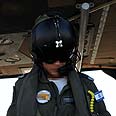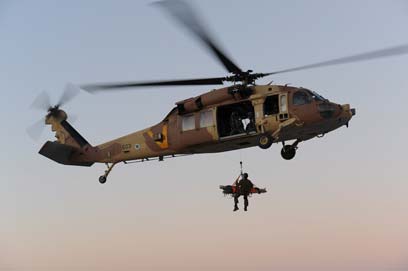
Women airborne mechanics flying high
They rescue injured people, operate helicopter equipment and get their hands dirty with grease and oil. Yedioth Ahronoth reporter accompanies two only IAF female airborne mechanics, learns that women can do everything – even better than men
3:00 pm – The Desert Birds Squadron at Hazerim base. A group approaches the Black Hawk helicopter; two pilots, airborne mechanics course commander Major Eran, and Merav and Hofit – both donning flight coveralls.
The helicopter blade spins vigorously; the noise of the engine is near-deafening. Merav and Hofit examine the equipment on the helicopter and strap themselves to the floor of the chopper. Everything is almost ready. Now all that's left to do is gather the hair in a pony tail, put on the helmet and take off.
Merav and Hofit are the only two female airborne mechanics in the Israel Air Force. The two are attractive young women with developed technical skills and a lot of motivation.
Many might think the job is the airborne version of a car mechanic – but one training flight with the two is enough to demonstrate how crucial their job is for the success of the mission.
Without fear
Minutes after the chopper takes off, Hofit, who is about to complete the course in a week, kneels down next to the door, which will soon be opened in order to increase the visibility while searching for injured people on the ground.This is probably the scariest corner of the helicopter, which I didn’t even dare come close to, but Hofit doesn’t hesitate. She has no fear. This is her job, and probably her favorite corner.
"Authorized to open door," the pilot instructs Hofit. She opens the door and attaches the crane – a cable that enables the helicopter to lift and lower people and equipment.
The wind is blowing in forcefully. "Fighters preparing. Sending down fighter. Two forward. One to the right. Stop right," she directs the pilot, and he follows her instructions.
"Sending down fighter. Fighter coming down. Fighter approaching ground. Fighters preparing," she continues.

'Every little error can cost lives.' (Photo: Haim Hornstein)
A fighter from Airborne Rescue And Evacuation Unit 669 descends to the ground in order to simulate an evacuation of an injured person.
"Stop above the position. Cable malfunction. Try to lift it from your position. Never mind, got it under control," Hofit says.
The fighter is lifted back into the helicopter with the stretcher attached to him. Throughout the mission, Hofit stands at the door of the helicopter and manages the operation. Everyone trusts her in this complicated and dangerous task, in which every small mistake can easily lead to a disaster.
The mission is completed successfully. Shortly after, the training is halted due to a real-time alert. The air crew might have to evacuate injured people who flipped over in a Hummer jeep while driving in the Negev. Everyone is all set for the mission, but eventually they receive an order to carry on with their exercise.
This is the routine job of airborne mechanics. They are part of the helicopter crew, and can be called to help save lives at any given moment.
"The airborne mechanic starts off as a mechanic, but is an integral part of the helicopter crew and joins every mission," explains Major Eran, the airborne mechanics course commander.
"During the course, the mechanics train to be air fighters, and also undergo infantry missions, navigation courses, escape drills and ground and aerial guidance. Of course they must also possess a technical sense," he adds.
Major Eran explains that "the airborne mechanics' job is essential and important, as they are involved in everything from evacuation of injured people, to lowering and lifting fighters with the crane, cooperating with ground forces and maintaining helicopter equipment such as fueling the helicopter etc'. In addition to all this, they are also the eyes of the pilot at the back of the chopper."
Don't want special treatment
Hofit and Merav are two out of the only five females in the history of the IDF that have become airborne mechanics. Maybe it’s the grease or the macho environment that has put off other girls. Or perhaps it’s the risk involved or the combination of words "airborne mechanic" that made them think that women are not cut out to deal with mechanics of any kind.These questions don't bother Merav and Hofit. They love their job, and are proud to do it as good as any other mechanic. They even like the grease. "We have a great technical sense," says Merav, who is in permanent service.
"If my mom can't do something, she immediately calls me and I fix it. The army only reinforced this skill. You need to like dealing with mechanics. To get your hands dirty sometimes – even if it's with grease," she notes.
"People think it sounds weird," says Hofit, "Everyone tells me that it's a man's job. You need to have a high motivation to be here. Even during operations, you naturally get examined more than men who do exactly the same thing. As a woman you always need to prove yourself."
The female airborne mechanics are adamant about not receiving special treatment. But even if they wanted such treatment, they wouldn't have gotten it at the squadron.
"We don't feel as if we are treated differently, and try not to ask for special conditions because we are girls. At the end of the day, during the missions we need to handle things on our own," they both agree.
"Although all the guys in the squadron are very supportive and the pilots trust us, it's some sort of an instinct to offer women help. For example when we lift something heavy, someone immediately offers to help, although we want to do it on our own," notes Merav.
"The girls are accepted like anyone else," says Major Eran. "Incorporating woman in the mechanic and combat apparatus is an excellent thing, and contributes a lot to the organization.
"Women have a different way of thinking and possess high motivation in a predominantly male environment. I will be happy if more women are incorporated into the field," he adds.
Squadron Commander Lieutenant-Colonel Z. doesn't regard the presence of women on the squadron as unusual. "We've already gotten used to it and it has become natural. As far as we are concerned female airborne mechanics get no special benefits," he stresses.
Same risks as pilots
The last IDF airborne mechanic to join the squadron before Merav was Keren Tendler, who was killed during the 2nd Lebanon War after a missile hit the helicopter she was on. Her story accompanies all airborne mechanics and reminds them of the dangers involved, just like those facing pilots and the rest of the flight crew.Despite the dangers, The IDF only recognized airborne mechanics as fighters two months ago.
"The Air Force always thought that we should be considered fighters because we are full partners in all missions and are facing the same risks as the rest of the crew," says Major Eran.
"We were recognized as fighters, and rightfully so," adds Merav. "We are part of the air crew, even when there's a risk, and there's always a risk. The responsibility is immense, and every little error I make can cost human lives."
Hofit and Merav work around the clock. "We are always doing some sort of activity. Even when there's no training or real time alert, there's always ground work to be done," Merav notes, adding, "We repair every malfunction in the helicopter, even if its changing a tier. This was the first training we did, and they won’t let us forget it."
Compared to other glory-shrouded positions in the Air Force, the airborne mechanics – for an unknown reason – receive little accolade. But this does not bother the girls either. They dream about continuing their job even after they complete the mandatory service.
"Even when I have my own family I see myself doing this and being part of the squadron," declares Hofit. "My job gives me huge pride, and proves that girls can do anything and deal with everything," she adds.
The red sun sets over Hazerim base. The air crew completes its training mission and begins night routine. After night falls, it becomes hard to distinguish between Merav and Hofit and their male counterparts.
"You get used to the male environment and many times it's a lot of fun, but sometimes a little female bonding is missing," says Merav.
"When I got here there wasn't even one female shoulder to lean on. Today I have Hofit, but we won't mind a few other female airborne mechanics to show everyone that woman can do everything."
- Follow Ynetnews on Facebook










